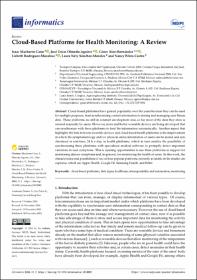Mostrar el registro sencillo del ítem
Cloud-Based Platforms for Health Monitoring: A Review
| dc.contributor.author | Machorro-Cano, Isaac | |
| dc.contributor.author | Olmedo-Aguirre, Jose Oscar | |
| dc.contributor.author | Alor-Hernández, Giner | |
| dc.contributor.author | Rodriguez-Mazahua, Lisbeth | |
| dc.contributor.author | Sanchez Morales, Laura Nely | |
| dc.contributor.author | Perez-Castro, Nancy | |
| dc.date.accessioned | 2024-01-15T23:40:16Z | |
| dc.date.available | 2024-01-15T23:40:16Z | |
| dc.date.issued | 2023-12-20 | |
| dc.identifier.issn | 2227-9709 | |
| dc.identifier.other | https://doi.org/ 10.3390/informatics11010002 | |
| dc.identifier.uri | http://repositorios.orizaba.tecnm.mx:8080/xmlui/handle/123456789/798 | |
| dc.description | Cloud-based platforms have gained popularity over the years because they can be used for multiple purposes, from synchronizing contact information to storing and managing user fitness data. These platforms are still in constant development and, so far, most of the data they store is entered manually by users. However, more and better wearable devices are being developed that can synchronize with these platforms to feed the information automatically. Another aspect that highlights the link between wearable devices and cloud-based health platforms is the improvement in which the symptomatology and/or physical status information of users can be stored and synchronized in real-time, 24 h a day, in health platforms, which in turn enables the possibility of synchronizing these platforms with specialized medical software to promptly detect important variations in user symptoms. This is opening opportunities to use these platforms as support for monitoring disease symptoms and, in general, for monitoring the health of users. In this work, the characteristics and possibilities of use of four popular platforms currently available in the market are explored, which are Apple Health, Google Fit, Samsung Health, and Fitbit. | es |
| dc.description.abstract | Cloud-based platforms have gained popularity over the years because they can be used for multiple purposes, from synchronizing contact information to storing and managing user fitness data. These platforms are still in constant development and, so far, most of the data they store is entered manually by users. However, more and better wearable devices are being developed that can synchronize with these platforms to feed the information automatically. Another aspect that highlights the link between wearable devices and cloud-based health platforms is the improvement in which the symptomatology and/or physical status information of users can be stored and synchronized in real-time, 24 h a day, in health platforms, which in turn enables the possibility of synchronizing these platforms with specialized medical software to promptly detect important variations in user symptoms. This is opening opportunities to use these platforms as support for monitoring disease symptoms and, in general, for monitoring the health of users. In this work, the characteristics and possibilities of use of four popular platforms currently available in the market are explored, which are Apple Health, Google Fit, Samsung Health, and Fitbit. | es |
| dc.description.sponsorship | TECNM, CONAHCYT | es |
| dc.language.iso | en | es |
| dc.publisher | MDPI Publishing | es |
| dc.relation.ispartofseries | Informatics; | |
| dc.subject | Healthcare | es |
| dc.subject | cloud-based platforms | es |
| dc.subject | monitoring | es |
| dc.title | Cloud-Based Platforms for Health Monitoring: A Review | es |
| dc.type | Article | es |
Ficheros en el ítem
Este ítem aparece en la(s) siguiente(s) colección(ones)
-
Artículos (DCI) [72]



